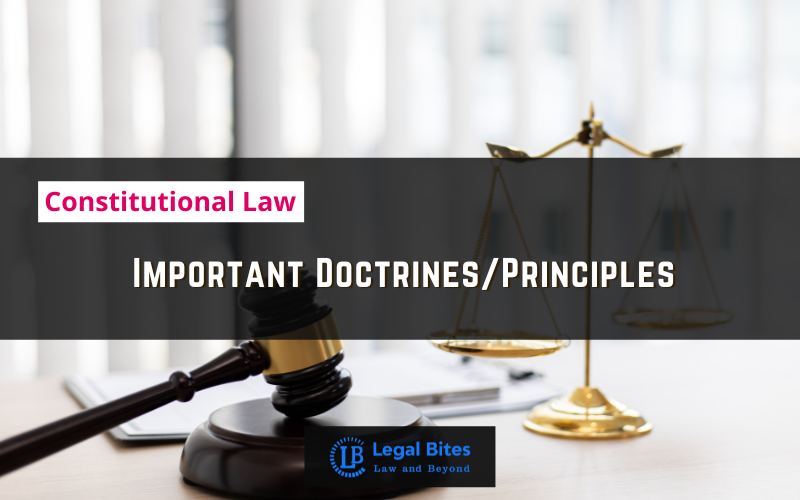What important points of law have been decided in the following reported judgments? [MS 1988]
Question: What important points of law have been decided in the following reported judgments? [MS 1988] Dhanpal Chettiar’ v. Yesodaiammal, AIR 1989 SC 745 P. Gupta Sr Others v. President of India, AIR 1982 SC 149. Keshavanand Bharti v. the State of Kerala, AIR 1973 SC 1461. Minerva Mills Ltd. v. Union of India, AIR 1980 SC 1978.… Read More »
;![What important points of law have been decided in the following reported judgments? [MS 1988] What important points of law have been decided in the following reported judgments? [MS 1988]](https://www.legalbites.in/wp-content/uploads/2020/09/Constitution-mains.png)
Question: What important points of law have been decided in the following reported judgments? [MS 1988] Dhanpal Chettiar’ v. Yesodaiammal, AIR 1989 SC 745 P. Gupta Sr Others v. President of India, AIR 1982 SC 149. Keshavanand Bharti v. the State of Kerala, AIR 1973 SC 1461. Minerva Mills Ltd. v. Union of India, AIR 1980 SC 1978. Find the answer to the mains question only on Legal Bites. [What important points of law have been decided in the following reported judgments?] Answer ...
Question: What important points of law have been decided in the following reported judgments? [MS 1988]
-
Dhanpal Chettiar’ v. Yesodaiammal, AIR 1989 SC 745
-
P. Gupta Sr Others v. President of India, AIR 1982 SC 149.
-
Keshavanand Bharti v. the State of Kerala, AIR 1973 SC 1461.
-
Minerva Mills Ltd. v. Union of India, AIR 1980 SC 1978.
Find the answer to the mains question only on Legal Bites. [What important points of law have been decided in the following reported judgments?]
Answer
1) Dhanpal Chettiar’ v. Yesodaiammal, AIR 1989 SC 745
Under this landmark judgment given by a seven-Judge Bench, the court’s ruling emphasized the need to have a uniform law in all the States despite having some difference in phraseology of relevant provisions in the State laws. No notice to quit was necessary under s. 106 of the T.P. Act to enable the landlord to get an order of eviction against the tenant. On the question of the requirement of notice under s.106, T.P act there is no scope for taking different views on the basis of difference in phraseology of the various Rent Acts. The difference in the language does not bring about any distinction.
2) P. Gupta Sr Others v. President of India, AIR 1982 SC 149.
In this case, Chief Justice Bhagwati, writing for the majority, advanced a few exceptions to the otherwise strict rules of who can pray for a writ of mandamus. It held that where a person who has suffered a legal wrong or a legal injury or whose legal right or legally protected interest is violated, is unable to approach the Court on account of some disability or it is not practicable for him to move the Court for some other sufficient reasons, such as his socially or economically disadvantaged position, some other person can invoke the assistance of the Court for the purpose of providing judicial redress to the person wronged or injured so that the legal wrong or injury caused to such person does not go un-redressed and justice is done to him.
3) Kesavanand Bharti v. State of Kerala, AIR 1973 SC 1461.
Through the present case, the Supreme Court has carefully interpreted the doctrine of basic structure and analyzes when a particular amendment is said to violate the basic structure of the Constitution of India. It has overruled the previous decision of the court in the Golaknath case and put a restriction on the wide power of the parliament on amending the constitution.
The Apex Court of India held by a majority of 7:6 that Parliament has the power and authority to amend any provision of the Indian Constitution to fulfill its socio-economic obligations guaranteed to the citizens under the preamble, subject to the sole condition that such an amendment would not change the basic structure of the constitution.
4) Minerva Mills Ltd. v. Union of India, AIR 1980 SC 1978.
In Minerva Mills v. Union of India, the Parliament, through the 42nd Constitutional Amendment Act, 1976, attempted to circumvent Kesavananda Bharati by making Parliamentary power unlimited. It indirectly declares that there is no limitation on the power of the parliament regarding the Amendment. The Court in this case struck down the amendment on the grounds that the judicial review of Parliamentary enactments and the limitation of Parliamentary power to amend the Constitution are part of the basic structure of the Constitution.
Important Mains Questions Series for Judiciary, APO & University Exams
- Constitutional Law Mains Questions Series Part-I
- Constitutional Law Mains Questions Series Part-I
- Constitutional Law Mains Questions Series Part-II
- Constitutional Law Mains Questions Series Part-IV
- Constitutional Law Mains Questions Series Part-V
- Constitutional Law Mains Questions Series Part-VI
- Constitutional Law Mains Questions Series Part-VII
- Constitutional Law Mains Questions Series Part-VIII
- Constitutional Law Mains Questions Series Part-IX
- Constitutional Law Mains Questions Series Part-X



